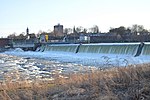Pioneer Valley Performing Arts Charter Public School
Charter schools in MassachusettsMassachusetts school stubsPublic high schools in MassachusettsPublic middle schools in MassachusettsSchools of the performing arts in the United States ... and 1 more
South Hadley, Massachusetts
Pioneer Valley Performing Arts Charter Public School (PVPA) is a public charter school in South Hadley, Massachusetts, United States. It was established in 1996 as part of the Massachusetts Educational Reform. It was originally located in Hadley, Massachusetts, but relocated to South Hadley for its tenth year in 2005.
Excerpt from the Wikipedia article Pioneer Valley Performing Arts Charter Public School (License: CC BY-SA 3.0, Authors).Pioneer Valley Performing Arts Charter Public School
Mulligan Drive,
Geographical coordinates (GPS) Address Nearby Places Show on map
Geographical coordinates (GPS)
| Latitude | Longitude |
|---|---|
| N 42.241305555556 ° | E -72.599305555556 ° |
Address
Mulligan Drive 15
01075
Massachusetts, United States
Open on Google Maps









